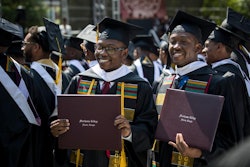Nearly two years after Hurricane Katrina’s floodwaters demolished much of New Orleans, officials at the city’s hard hit historically Black universities are busy updating their disaster plans in the face of another hurricane season.
Xavier University of New Orleans ramped up its emergency preparedness plans before Hurricane Katrina ever headed its way, taking the initiative after two tropical storms drenched the city in advance of the bigger storm. The university developed a backup Web site and toll-free phone number that students, faculty and staff could connect to in times of disaster. But now it is adding an extra layer of precaution, says Warren Bell Jr., the university’s associate vice president for university media relations.
Before the tropical storms, Bell says, school officials had to rely on local media to get information to the campus community. That approach often led to the dissemination of inaccuracies, he says.
“After Katrina, we added a campus text messaging system for our students and faculty members,” he says. “We’ll send critical messages to their cell phones or personal data assistants advising them of closings, flooding or other weather emergencies.”
Xavier reopened its doors three months after Katrina’s floodwaters finally receded. Neighboring HBCUs Dillard University and Southern University-New Orleans, however, required a little more time to recover. All three institutions suffered millions of dollars in damage, and millions more in lost tuition as students fled to other parts of the country.
Unlike their predominantly White counterparts, New Orleans’ HBCUs did not have the extensive endowment and operating funds needed to cope with a disaster of Katrina’s magnitude. Yet each overcame in the wake of the historic storm as enrollments as well as campus life are slowly returning to normal.
The National Hurricane Center this month predicted another active season but with the help of donations and sheer willpower, the city’s three HBCUs are rebuilding and shoring up for the next big storm.
Mary Wells, Southern University’s training coordinator for emergency planning, says all of its campuses — including SUNO — are in the process of developing training for all faculty and staff, which will eventually filter down to students.
SUNO suffered about $500 million in damages, officials say.
“In hindsight of Katrina, we’re actually undergoing a new training program for students, faculty and staff. Even our board of directors will undergo a type of training,” says Wells, adding that staff must complete the training by June 1, the start of the upcoming hurricane season.
In addition to learning how to rescue others and put out fires, SUNO is also shoring up the training and increasing the number of building wardens it has, she says. “We realized we needed more structuring to make responses more viable in all buildings.”
For the SUNO campus, specifically, one staff person has received the training thus far, says Harold Clark, the executive associate to the chancellor. The city of New Orleans, however, shared emergency preparedness information with students, faculty and staff free of charge, he says.
SUNO is also discussing locating data on its mainframe off-site, housing it in Colorado, so that it is accessible during a disaster, Clark says.
Dillard, set in the still-devastated Gentilly neighborhood, estimated its post-Katrina damages at $400 million. Dillard lost three student housing facilities to fire, and every building was inundated with water, except for the chapel, says Karen Celestan, the senior director of university communications.
Like Xavier and SUNO, Dillard had emergency preparedness plans already in place before Katrina.
Dillard had a long-standing agreement with Centenary University in Shreveport, La., to temporarily locate students and faculty there when facing weather evacuations.
“Whenever we had to evacuate for a hurricane, there was an agreement that our students would evacuate there and then come back a few days later,” says Celestan, who did not work for Dillard when Katrina hit in 2005. “With Katrina, we couldn’t come back and our students were dispersed across the country.” That’s why Dillard is now updating its Web site to better track students if they have to evacuate. They will also use the system to run the university online if need be, Celestan says.
Although she declines to state the costs of updating Dillard’s emergency plan, she does say the improvements are ongoing. “The best teacher, unfortunately, is disaster. Katrina taught us all a lesson,” she says.
Heralded for placing more Black students in medical school than any other institution in America, Xavier was able to keep much of its reputation intact though it still had to make $45 million in repairs to its infrastructure when it re-opened in January 2006.
In addition to its toll-free number and back-up Web site, Xavier is now requiring all students to read and sign the school’s new emergency preparedness plan. Part of that plan states that students and their families are responsible for making sure they get out of harm’s way during weather-related disasters.
“During Hurricane Katrina, 150 students were left behind because they had no way home,” Bell says. “Students now know that they are expected to have, in advance, ways to leave campus on their own in the event of another hurricane.”
And once the students are safely away from the area, the university’s new text messaging system should keep them in the loop with events on campus.
Crystal N. Moore, president of the school’s student government, convinced Xavier’s administrators to invest in the emergency system, which was launched in April. Currently, about 1,200 students and faculty — mostly students — have signed up for it. The number is less than half of the campus population, officials say.
“Not everyone checks their e-mail frequently, but we all get our text messages right away,” Moore said in a campus interview posted on Xavier’s primary Web site. “When the power went out on campus back in February after the overnight tornadoes, nobody knew what was going on. With E2Campus in place next time, we’ll receive the information as soon as the university sends it.”
Signing up for the text messaging service is free and voluntary, but costs the university about $1 per user, officials say.
There are currently 0 comments on this story.
Click here to post a comment.
© Copyright 2005 by DiverseEducation.com


















